文章信息
- 蒋万祥, 贾兴焕, 唐涛, 蔡庆华
- JIANG Wanxiang, JIA Xinghuan, TANG Tao, CAI Qinghua.
- 底栖动物功能摄食类群对酸性矿山废水的响应
- Response of macroinvertebrate functional feeding groups to acid mine drainage in the Gaolan River
- 生态学报[J]. 2016, 36(18): 5670-5681
- Acta Ecologica Sinica[J]. 2016, 36(18): 5670-5681
- http://dx.doi.org/10.5846/stxb201504140760
-
文章历史
- 收稿日期: 2015-04-14
- 网络出版日期: 2016-01-05
2. 中国科学院水生生物研究所淡水生态与生物技术国家重点实验室, 武汉 430072;
3. 中国林业科学研究院亚热带林业研究所国家林业局杭州湾湿地生态系统定位研究站, 富阳 311400
2. State Key Laboratory of Freshwater Ecology and Biotechnology, Institute of Hydrobiology, Chinese Academy of Sciences, Wuhan 430072, China;
3. Research Institute of Subtropical Forestry, CAF; Wetland Ecosystem Research Station of Hangzhou Bay, State Forestry Administration, Fuyang 311400, China
近年来, 在研究生态系统的结构和功能时, 生态学家越来越把注意力集中在对生物的非系统分类的分析上。群落生态学家正在试图把生物类群划分为具有共同功能特征或利用相同资源基础的类群, 他们以生态学而不是纯粹的分类学标准为基础, 这有助于在生态学研究中简化群落内物种之间的关系, 使得生态系统的复杂性在研究工作中减小[1]。国际地圈-生物圈计划(IGBP)的核心项目“全球变化和陆地生态系统”研究(Global Change and Terrestrial Ecosystem, GCTE)采用了以生物本身的功能来划分类群的概念作为其运作计划的基础部分, 并且指出可以通过把物种归并为有限的几个功能类群来了解生态系统的基本动态[2]。
酸性矿山废水是金属硫化物暴露于空气和水中时在硫化细菌的作用下产生的[3], 具有低pH值、高重金属含量的特征。它往往通过地表径流和地下渗透等形式, 使得地表水和地下水酸化和盐化, 通常对生态区系产生较大的负面影响[4]。重金属元素作为酸性矿山废水携带的主要环境污染物, 具有难降解、易积累、毒性大等特点, 并具有通过食物链危害人类健康的潜在危险, 备受环境工作者关注[5]。
底栖动物因具有较高的生物多样性, 移动能力弱, 对污染等不利环境因素没有或很少有回避性等特征[6-7], 一直是评价河流生态系统健康最为重要的类群[8]。本研究选取香溪河主要支流高岚河为对象, 就该区域底栖动物功能摄食类群分布格局及其对酸性矿山废水的响应性进行研究, 以期为该区域生物多样性保护、水质生物学评价及流域综合管理提供相关数据及理论基础。
1 材料与方法 1.1 样点概况与设置香溪河发源于神农架林区, 干流全长94 km, 流域面积3099 km2, 是三峡水库湖北库区最大的支流, 河口距三峡大坝坝首仅32 km, 其健康状况对三峡水库水质有直接影响[9-10]。三峡大坝运行以来, 香溪河因其地理位置的重要性而备受关注, 相关研究频见报道[11-18]。
高岚硫铁矿位于香溪河支流高岚河的上游, 虽因三峡大坝的修建于2004年前后停止开采, 但废矿产生的酸性废水仍常年流入高岚河, 致使高岚河成为一条典型的上源污染型河流[19]。本研究选取3个河段就底栖动物功能摄食类群对酸性矿山废水的响应进行探讨:1)自硫铁矿到高岚河支流夏阳河汇入点为受损河段, 选取3个样点(G1—G3);该河段不同程度地被废矿沉积物覆盖, 污染严重;2)以受污染的夏阳河作为对照河段, 选取4个对照样点(D1—D4), 其中D1海拔较高, 生境特征与硫铁矿处相似;从夏阳河汇入点起选取5个样点(G4—G8), 作为恢复河段;由于夏阳河等支流的汇入及沉降作用, 酸性矿山废水对该河段的影响逐渐减小。
1.2 采样时间和方法2006年9 、11月及2007年1、3、5、7月每月中旬用40目网径、采样面积0.09 m2的索伯网(surber sampler)顺水流方向沿断面分左中右各采集1次, 将网中的底栖动物拣出, 分装到3个标本瓶中, 并用10%的福尔马林液固定, 标本带回实验室后分类[20-21]、计数, 最后用吸水纸吸干底栖动物表面液体, 用万分之一天平(赛多力斯)称重(湿重)。由于降雨导致突发性洪水, 2006年9月和2007年5月仅采集G1—G5和D2—D4 8个样点底栖动物, 本研究共采集底栖动物标本192个。
1.3 底栖动物功能摄食类群划分底栖动物功能摄食类群(functional feeding groups, FFGs)最初是由Cummins[22]在20世纪70年代提出, 主要分为刮食者(SC), 主要以各种营固着生活的生物类群为食, 如着生藻类等;撕食者(SH), 主要以各种凋落物和粗有机颗粒(CPOM, 粒径>1mm)为食;收集者(GC), 主要取食河底的各种有机颗粒物;滤食者(FC), 以水流中的细有机颗粒物(FPOM, 0.45mm<粒径<1mm)为食;捕食者(PR), 以捕食其它水生动物为食[23-24]。
1.4 项目测定与方法pH值(pH)、电导(Conductivity, Cond)、水温(Water temperature, WT)、总溶解性固体(Total dissolved solid, TDS)、盐度(Salinity, Sal)、溶氧(Dissolved oxygen, DO)用HORIBA W-23多参数水质分析仪测定, 流速(Velocity, V)用LJD型打印式流速仪测定断面0.6倍水深处流速, 水深(Water depth, Dep)和水面宽度(Water width, Wid)用卷尺测定。
用干净的塑料瓶于每个样点采集3个重复水样, 放于有冰块的保温箱中, 带回实验室后将水样用0.45 μm的微孔滤膜抽滤, 取一定量抽滤后的水样, 配成1%HNO3的溶液, 用电感耦合等离子体原子吸收发射光谱分析仪(ICP-AES)测量水样中各种金属含量。本研究测量的金属指标有Cd、Cr、Cu、Mn、Pb、Zn、Fe、Al、Ca和Mg。
1.5 数据分析本研究样点图制作使用的软件为ArcGIS 10.0, 方差分析使用的软件为SPSS 11.5, 非度量多维标度排序和多响应置换过程分析使用的软件为PC-ORD 4.0, 典型对应分析使用的软件为Canoca 4.5。
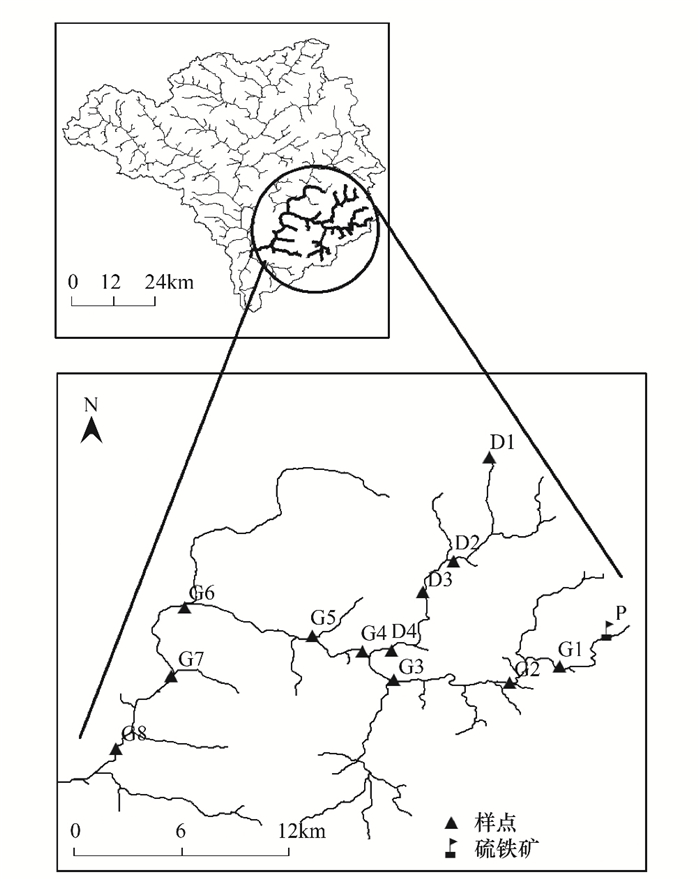
|
| 图 1 香溪河水系及样点分布图 Fig. 1 Xiangxi River system and location of the sampling sites |
对高岚河水体中Cd、Cr、Cu、Mn、Pb、Zn、Fe、Al、Ca和Mg等10种元素含量的分布规律进行分析(表 1), 结果表明, 除Mg、Ca外, 各种金属含量在受损河段(特别是G1、G2点)明显高于其它河段, 各种金属最高含量均出现在受损河段的G1点。Mg含量最高点出现在高岚河下游样点, 从夏阳河汇入点开始, 其在高岚河水体中的含量表现出逐渐增加的趋势。Ca、Mg含量沿高岚河并未表现出明显的下降趋势, 张建立等[25]认为是矿山酸性废水与含Ca、Mg的碳酸盐矿物接触发生一系列化学反应所致。
| 样点Sites | Al | Ca | Cd | Cu | Fe | Mg | Mn | Pb | Cr | Zn |
| D1 | 278.45 | 119736.90 | 2.25 | 27.21 | 114.11 | 54270.32 | 21.53 | 4.91 | 5.85 | 79.85 |
| D2 | 516.74 | 98895.96 | 1.54 | 37.58 | 830.96 | 33319.18 | 14.49 | 7.17 | 14.42 | 48.70 |
| D3 | 411.27 | 127659.68 | 1.00 | 42.80 | 303.76 | 54201.80 | 14.34 | 9.82 | 9.45 | 38.26 |
| D4 | 345.55 | 144568.02 | 2.03 | 42.26 | 165.68 | 53591.14 | 7.38 | 8.39 | 13.61 | 48.28 |
| G1 | 78714.57 | 184481.57 | 19.37 | 139.75 | 42209.19 | 94172.51 | 4982.10 | 89.74 | 83.23 | 314.32 |
| G2 | 18072.41 | 186071.83 | 2.23 | 68.68 | 2029.98 | 63192.81 | 1897.41 | 27.62 | 16.25 | 143.44 |
| G3 | 845.49 | 140665.23 | 2.40 | 47.02 | 311.74 | 53334.84 | 1132.13 | 33.81 | 16.98 | 66.97 |
| G4 | 465.45 | 156587.57 | 1.41 | 42.65 | 277.48 | 47536.10 | 254.30 | 9.50 | 12.41 | 41.05 |
| G5 | 313.61 | 201421.60 | 1.46 | 33.00 | 155.44 | 85776.73 | 47.95 | 10.44 | 12.64 | 22.33 |
| G6 | 302.71 | 81478.61 | 0.87 | 36.53 | 79.75 | 40235.16 | 93.77 | 3.86 | 6.13 | 18.61 |
| G7 | 189.01 | 120956.06 | 1.18 | 26.75 | 164.01 | 63800.19 | 9.85 | 3.62 | 9.02 | 30.25 |
| G8 | 390.96 | 140091.23 | 1.32 | 27.68 | 188.43 | 60255.12 | 19.03 | 6.49 | 9.31 | 19.24 |
对各样点pH值(pH)、电导(Cond)、总溶解性固体(TDS)、盐度(Sal)、溶解氧(DO)、水温(WT)、流速(V)、水深(Dep)、水面宽度(Wid)等9项理化指标进行分析(表 2)。结果表明, 电导、总溶解性固体在G1点含量明显高于其它样点;pH值在受损河段表现为较强的酸性, 特别是在G1和G2两个样点, 其平均值分别为3.87和4.83;溶解氧含量在G1和G2点也低于其它样点。
| 样点 Sites |
pH值 | 电导 Conductivity/(us/cm) |
总溶解性固体 Total dissolved solid/(mg/L) |
盐度 Salinity |
溶解氧 Dissolved oxygen/(mg/L) |
水温 Water temperiture/℃ |
流速 Velocity/(m/s) |
水面宽度 Water width/m |
水深 Water Depth/m |
| D1 | 8.48 | 255.6 | 144.63 | 0.08 | 8.32 | 12.62 | 0.49 | 1.29 | 0.15 |
| D2 | 8.6 | 117.5 | 62.03 | 0.05 | 8.73 | 15.64 | 0.45 | 6.12 | 0.24 |
| D3 | 7.94 | 166.62 | 91.08 | 0.06 | 8.92 | 16.66 | 0.5 | 6.99 | 0.22 |
| D4 | 8.15 | 169.33 | 99.7 | 0.06 | 8.26 | 17.44 | 0.48 | 5.83 | 0.25 |
| G1 | 3.87 | 698 | 288 | 0.19 | 8.04 | 14.9 | 0.62 | 2.98 | 0.19 |
| G2 | 4.83 | 259.35 | 145.45 | 0.07 | 8.13 | 16.56 | 0.58 | 8.44 | 0.22 |
| G3 | 6.17 | 202.02 | 106.73 | 0.06 | 8.66 | 16.62 | 0.43 | 9.92 | 0.25 |
| G4 | 7.46 | 190.78 | 82.63 | 0.06 | 9.08 | 17.3 | 0.34 | 16.13 | 0.27 |
| G5 | 8.16 | 308 | 163.03 | 0.1 | 9.15 | 18.64 | 0.38 | 8.69 | 0.25 |
| G6 | 7.89 | 189.43 | 100.07 | 0.1 | 8.84 | 14.08 | 0.4 | 12.14 | 0.22 |
| G7 | 7.92 | 285.67 | 128.27 | 0.12 | 8.66 | 15.79 | 0.34 | 17.4 | 0.25 |
| G8 | 8.22 | 268.25 | 150.87 | 0.12 | 9.72 | 14.54 | 0.52 | 31.67 | 0.36 |
本研究共采集底栖动物213种, 隶属7纲, 59科, 4亚科, 138属;水生昆虫占绝对优势, 相对丰度为96.7%, 分类单元数占总分类单元的91.0%。按照Bunn等[26]把相对丰度大于5%的类群定义为优势种, 发现四节蜉(Baetis sp.)、侧枝纹石蛾(Ceratopsyche sp.)、锯形蜉(Serratella sp.)和扁蜉(Heptagenia sp.)为研究区域优势类群, 相对丰度分别为18.7%、11.3%、9.6%和7.2%。
对底栖动物功能摄食类群进行分析, 发现收集者相对丰度最大, 其次为刮食者和滤食者, 捕食者和撕食者最小, 相对丰度分别为48.8%、20.6%、17%、9%、4.7%。其中, 收集者优势类群为四节蜉、锯形蜉、细蜉(Caenis sp.)、直突摇蚊一种(Orthocaldius tvetenia);刮食者优势类群为扁蜉、瘤石蛾一种(Lithax sp.)、高翔蜉(Europe sp.);滤食者优势类群为侧枝纹石蛾、短脉石蛾(Cheumatopsyche sp.)、黑蝇(Simulium sp.)、弓石蛾(Arctopsyche sp.);捕食者优势类群为壳粗腹摇蚊(Conchapelopia sp.)、大蚊科一种(Dicranota sp.)、三角涡虫(Dugesia sp.)、幽蟌科一种(Euphaeidae spp.)、流粗腹摇蚊一种(Rheopelopia acra)、龍虱科一种(Dytiscidae Liodessus sp.)、粗腹摇蚊一种(Rheopelopia paramaculipennis);撕食者优势类群为倍叉襀一种(Amphinemura sp.)、拟卷襀一种(Paraleuctra sp.)、委瑞环足摇蚊(Cricotopus vierriensis)、环足摇蚊一种(Cricotopus politus)、诺虫襀一种(Rhopalopsole sp.)。
2.3 功能摄食类群群落结构特征 2.3.1 功能摄食类群相对丰度对底栖动物功能摄食类群相对丰度空间动态进行分析(图 2), 结果表明, 高岚河上游受损河段各样点底栖动物功能摄食类群相对比较单一, 仅2007年3月份G3号样点采集到的底栖动物隶属4个功能摄食类群, 其次是2007年5月和2007年7月, G2号样点采集到的底栖动物隶属3个功能摄食类群, 上游其它样本底栖动物所属功能摄食类群均不超过两个, 特别是G1点, 在2006年9月、11月和2007年1月、7月均未采集到大型底栖动物;在受损河段采集到的所有样本中, 刮食者仅在2007年3月G3号样点出现。
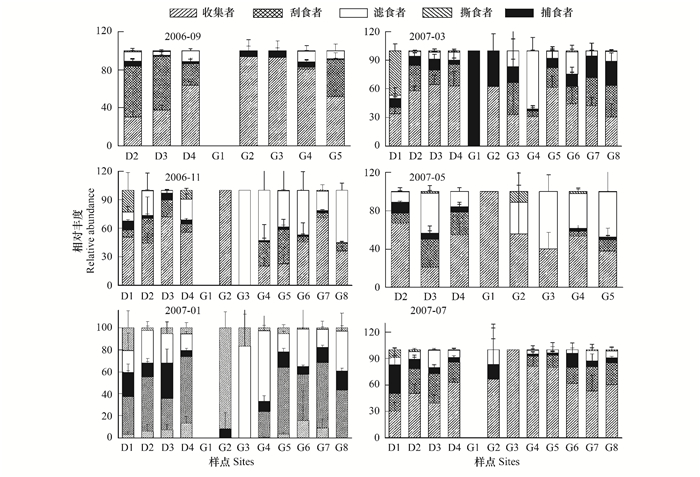
|
| 图 2 不同月份各样点大型底栖动物各功能摄食类群的密度相对丰度 Fig. 2 The density relative abundance of Functional Feeding Groups among different sites in different Month |
对底栖动物功能摄食类群密度进行分析(图 3), 结果表明, 滤食者密度均值在对照河段、受损河段和恢复河段分别为425.6、8.2、715.7个/m2;收集者密度均值在对照、受损和恢复河段分别为1812.8、26.3、1493.7个/m2;捕食者密度均值在对照、受损和恢复河段分别为388.4、3.7、221.5个/m2;刮食者密度均值在对照、受损和恢复河段分别为809.1、7.8、579.2个/m2;撕食者密度均值在对照、受损和恢复河段分别为290.7、5.3、34.9个/m2。方差分析(One-Way ANOVA)表明, 各功能摄食类群密度在受损河段(G1—G3)明显低于对照河段和恢复河段(P<0.01);对照河段和恢复河段密度差异不显著(P>0.05)。
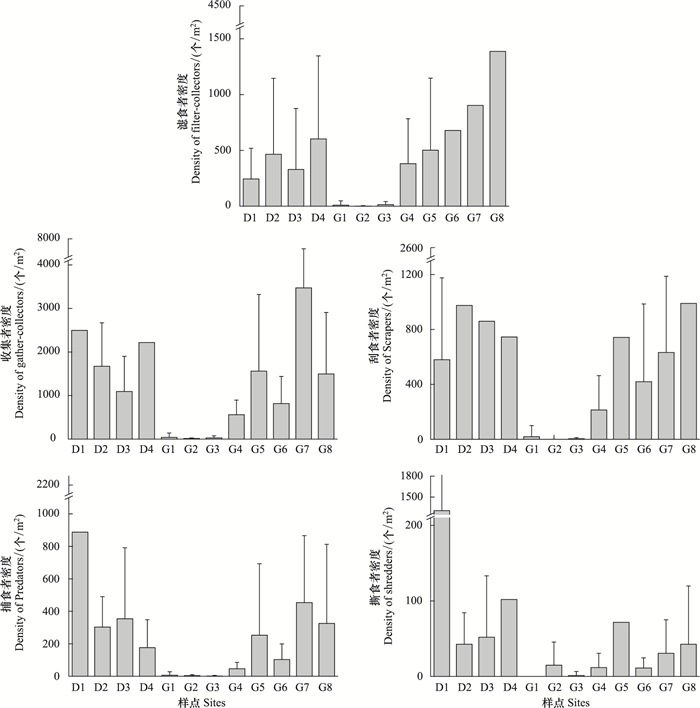
|
| 图 3 底栖动物功能摄食类群密度空间分布 Fig. 3 The spatial distribution of functional feeding groups density |
对功能摄食类群生物多样性进行分析(图 4), 结果表明, 对照、受损和恢复河段滤食者Shannon-Wiener多样性指数均值分别为0.73、0.03、0.36;收集者分别为1.18、0.10、1.03;刮食者分别为0.84、0.01、0.84;捕食者分别为1.03、0.01、0.60;撕食者分别为0.25、0.00、0.08。对照、受损和恢复河段滤食者物种丰度均值分别为2.94、0.26、1.93;收集者分别为8.56、0.78、6.74;刮食者分别为4.64、0.11、4.17;捕食者分别为4.64、0.22、2.69;撕食者分别为1.55、0.15、0.64。

|
| 图 4 功能摄食类群生物多样性比较 Fig. 4 Comparison of functional feeding group biodiversity |
方差分析表明, 收集者、刮食者、捕食者shannon-Wiener多样性指数和物种丰富度均表现为对照河段和恢复河段均同受损河段差异显著(P<0.05), 对照河段同恢复河段差异不显著(P>0.05);滤食者shannon-Wiener多样性指数和物种丰富度表现为对照河段>恢复河段>受损河段(P<0.05);撕食者shannon-Wiener多样性指数和物种丰富度均表现为对照河段同受损河段和恢复河段差异显著(P<0.05), 受损河段shannon-Wiener多样性指数同恢复河段差异不显著(P>0.05), 受损河段物种丰富度同恢复河段差异显著(P<0.05)。
2.3.4 非度量多维标度排序根据6次采样各样本大型底栖动物功能摄食类群物种组成特点及各分类单元密度均值, 对12个站位36个样点(未采集到底栖动物的样本不参与分析)的各功能摄食类群群落结构进行非度量多维标度排序(Non-metric multidimensional scaling, NMS)2维分析(图 5)。结果表明, 各功能摄食类群底栖动物群落结构排序规律较为一致, 即恢复河段5个样点(G4—G8)与对照河段(D1—D4)距离非常近, 而受损河段样点(G1—G3)与恢复河段和对照河段样点距离较远;表明底栖动物群落结构在对照河段和恢复河段具有较高的相似性, 而受损河段底栖动物群落结构同对照河段和恢复河段存在较大差异。应用多响应置换过程(multi-response permutation procedures, MRPP)分析进一步就底栖动物各功能摄食类群群落结构在3个河段间的差异进行分析, 结果表明, 受损河段底栖动物各功能摄食类群群落结构同对照河段和恢复河段差异极为显著(P<0.01)。
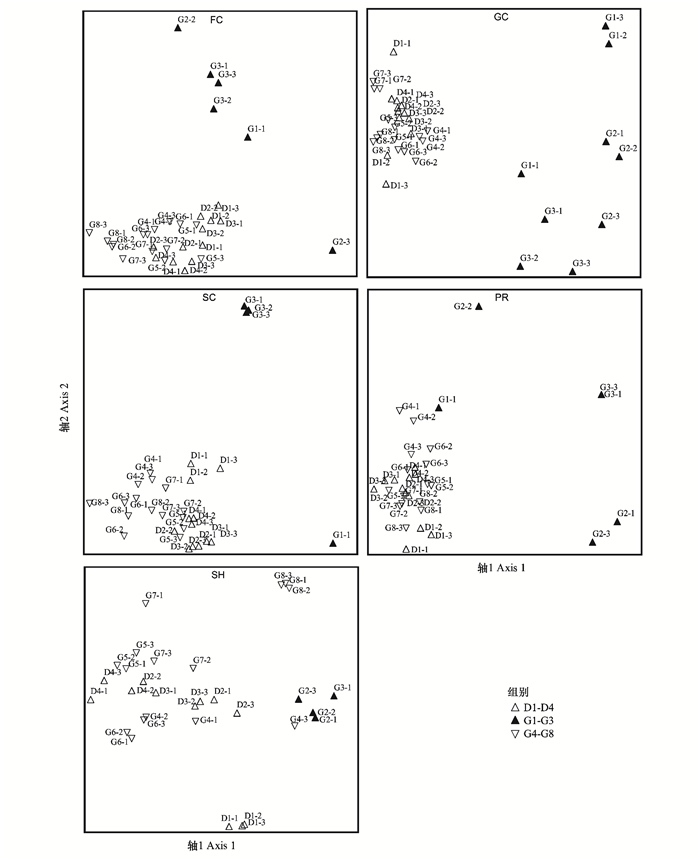
|
| 图 5 底栖动物功能摄食类群群落结构非度量多维标度排序 Fig. 5 The non-metric multidimensional scaling ordinal configuration of macroinvertebrate functional feeding groups community structure |
为明确底栖动物功能摄食类群对环境因子的响应, 对功能摄食类群群落结构同pH值(pH)、水深(Depth)、总固体悬浮物(TDS)、流速(V)、电导(Cond)、水温(WT)、溶解氧(DO)、盐度(Sal)、二氧化硅(SiO2)、Cd、Cr、Cu、Mn、Pb、Zn、Fe、Al、Ca和Mg进行典型对应分析(CCA)(图 6)。通过蒙特卡罗检验(Monte Carlo Permutation Test), 排除贡献小的因子, 结果表明, 滤食者受水温、溶解氧、Zn、pH值和Ca影响最大(P<+0.05);收集者受水温、水深、溶解氧、盐度、Ca和pH值影响最大(P<0.05);刮食者受水温、水深、河宽、Zn、Fe、Mn、Ca、总固体悬浮物和溶解氧影响最大(P<0.05);捕食者受水温、水深、河宽、溶解氧、盐度、总固体悬浮物、Cd、Zn、Ca、Mg、pH值影响最大(P<0.05);撕食者受水温、水深、河宽、溶解氧、流速、pH值、电导、总固体悬浮物、Ca、Mg和Zn影响最大(P<0.05)。
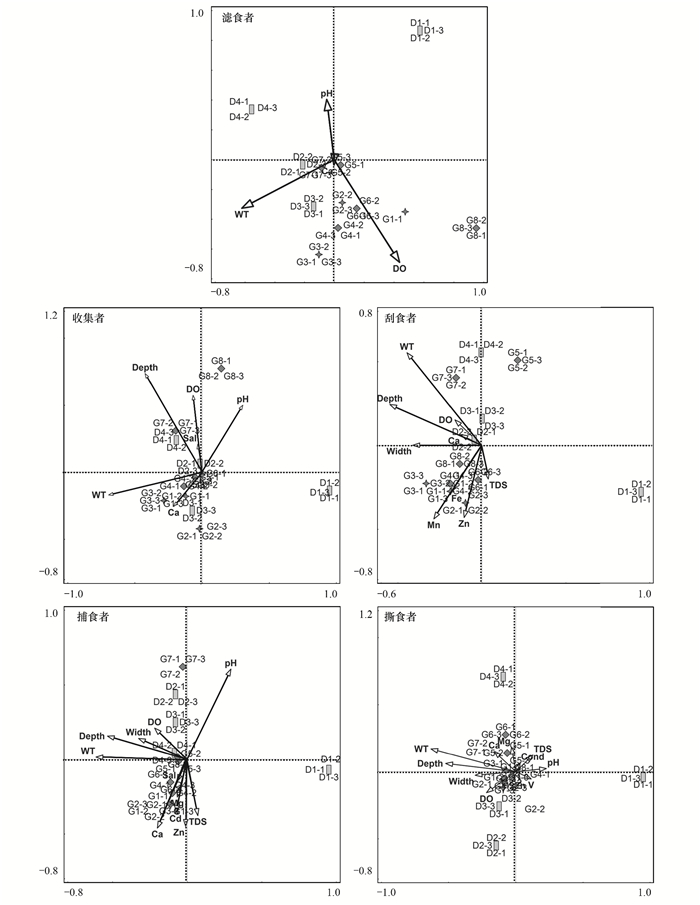
|
| 图 6 底栖动物功能摄食类群同环境因子的典型对应分析 Fig. 6 CCA ordination diagrams of macroinvertebrates functional feeding groups: site-environment variable |
功能摄食类群对研究底栖动物群落结构和功能组成具有重要作用[27]。相对丰度反映了各站点功能摄食类群组成情况, 本研究受损河段底栖动物功能摄食类群组成相对单一是其对酸性矿山废水的响应;刮食者对酸性矿山废水反应最为敏感, 受损河段仅在2007年3月G3号样点出现, 主要是因为该河段底层为废矿沉积物覆盖, 水体pH值较低, 其主要食物来源附石性藻类生长受限。密度是各功能摄食类群实际分布情况的反映, 受损河段底栖动物各功能摄食类群密度明显低于其它河段, 表明矿山酸性废水的排放已经对底栖动物的生存产生了非常严重的影响。生物多样性指数提供了更多有关群落方面的信息, 多用来指示环境的变化[28]。各功能类群Shannon-Wiener多样性指数和物种丰度在受损河段明显低于其它河段, 表明受损河段河流生态环境已受到严重破坏;撕食者多样性指数在恢复河段明显小于对照河段, 是因恢复河段处于河流的中下游, 植被郁闭度较低, 河道中枯枝落叶等撕食者食物较之对照河段明显减少, 限制了撕食者的生存。
非度量多维标度排序被认为是最好的技术之一, 它用于分析不同样方群落结构的距离关系(相似性)十分适宜, 直观地将群落标于多维坐标中, 特别适合连续梯度变化的群落关系分析[29]。本研究受损河段底栖动物各功能摄食类群群落结构同其它河段存在较大的差异, 而恢复河段群落结构和密度、多样性指数等参数一样同对照河段较为相似, 表明酸性矿山废水对受损河段底栖动物群落结构产生了较大影响, 随着夏阳河等其它河流的汇入, 使酸性矿山废水得以稀释, 生境得到较大的恢复, 底栖动物群落结构趋于复杂。
典型对应分析是把CA/RA和多元回归结合起来, 每一步计算结果都与环境因子进行回归, 详细的研究生物与环境的关系。不同于直接梯度分析, CCA可以结合多个环境因子一起分析从而更好的反映群落与环境的关系。本研究底栖动物功能摄食类群群落结构同环境因子典型对应分析表明, 除气候的季节更替导致水温、水深等理化因子的改变及底栖动物自身的季节性演替外, 不仅酸性矿山废水携带的金属元素和低pH值水体对底栖动物群落结构已经产生了较大的影响, 由于酸性矿山废水的排放而导致水体中离子含量增加, 溶解性固体含量增加及其沉积作用, 及离子氧化对水体中溶解氧的消耗均对底栖动物群落结构遭成了较大影响。
河流连续统(River Continuum Concept, RCC)理论认为河流从源头到河口是一个连续、统一的系统, 这种连续性不仅是地理空间上的连续, 更重要的是沿河纵向有机物数量、资源分配、水生摄食功能类群的连续[30]。通过比较研究发现, 高岚硫铁矿产生的酸性矿山废水对底栖动物功能摄食类群组成、密度、生物多样性及群落结构均有显著影响, 酸性矿山废水的排放严重影响了功能摄食类群的连续性, 表明底栖动物功能摄食类群对矿山酸性废水引起的生态效应的响应非常敏感。
致谢: 中国科学院水生生物研究所董笑语帮助软件使用, 李凤清、段树桂先生协助野外采样, 特此致谢。| [1] | Kikkawa J, Anderson D J. Community Ecology:Pattern and Process. Melbourne:Blackwell Scientific Publications , 1986 : 65–99. |
| [2] | 袁兴中, 陆健健, 刘红. 长江口底栖动物功能群分布格局及其变化. 生态学报 , 2002, 22 (12) : 2054–2062. |
| [3] | Sabatier S, Buchaca T, Cambra J, Catalan J, Guasch H, Ivorra N, Munoz I, Navarro E, Real M, Romani A. Structure and function of benthic algal communities in an extremely acid river. Journal of Phycology , 2003, 39 (3) : 481–489. DOI:10.1046/j.1529-8817.2003.02104.x |
| [4] | Cherry D S, Currie R J, Soucek D J, Latimer H A, Trent G C. An integrative assessment of a watershed impacted by abandoned mined land discharges. Environmental Pollution , 2001, 111 (3) : 377–388. DOI:10.1016/S0269-7491(00)00093-2 |
| [5] | 程杰, 李学德, 花日茂, 唐俊, 卢洪秀. 巢湖水体沉积物重金属的分布及生态风险评价. 农业环境科学学报 , 2008, 27 (4) : 1403–1408. |
| [6] | Heino J, Louhi P, Muotka T. Identifying the scales of variability in stream macroinvertebrate abundance, functional composition and assemblage structure. Freshwater Biology , 2004, 49 (9) : 1230–1239. DOI:10.1111/fwb.2004.49.issue-9 |
| [7] | Chainho P, Costa J L, Chaves M L, Chainho P, Lane M F, Dauer D M, Costa M J. Seasonal and spatial patterns of distribution of subtidal benthic invertebrate communities in the Mondego River, Portugal-A poikilohaline estuary. Hydrobiologia , 2006, 555 (1) : 59–74. DOI:10.1007/s10750-005-1132-2 |
| [8] | Hawkes H A. Invertebrates as indicators of river water quality//James A, Evison L, eds. Biological Indicators of Water Quality. New York: John Wiley and Sons, 19791–45. |
| [9] | Wu N C, Tang T, Zhou S C, Jia X H, Li D F, Liu R Q, Cai Q H. Changes in benthic algal communities following construction of a run-of-river dam. Journal of the North American Benthological Society , 2009, 28 (1) : 69–79. DOI:10.1899/08-047.1 |
| [10] | 蒋万祥, 傅小城, 唐涛, 蔡庆华. 香溪河水系大型底栖动物的群落结构及生态位. 应用与环境生物学报 , 2009, 15 (3) : 337–341. |
| [11] | Ye L, Cai Q H, Zhang M, Tan L. Real-time observation, early warning and forecasting phytoplankton blooms by integrating in situ automated online sondes and hybrid evolutionary algorithms. Ecological Informatics , 2014, 22 : 44–51. DOI:10.1016/j.ecoinf.2014.04.001 |
| [12] | Wu N C, Jiang W X, Fu X C, Zhou S C, Li F Q, Cai Q H, Fohrer N. Temporal impacts of a small hydropower plant on benthic algal community. Fundamental and Applied Limnology (Archiv für Hydrobiologie) , 2010, 177 (4) : 257–266. DOI:10.1127/1863-9135/2010/0177-0257 |
| [13] | Zhou S C, Huang X F, Cai Q H. Temporal and spatial distributions of rotifers in Xiangxi Bay of the Three Gorges Reservoir, China. International Review of Hydrobiology , 2009, 94 (5) : 542–559. DOI:10.1002/iroh.v94:5 |
| [14] | 蒋万祥, 蔡庆华, 唐涛, 吴乃成, 傅小城, 李凤清, 刘瑞秋. 香溪河大型底栖无脊椎动物空间分布. 应用生态学报 , 2008, 19 (11) : 2443–2448. |
| [15] | 蒋万祥, 贾兴焕, 周淑婵, 李凤清, 唐涛, 蔡庆华. 香溪河大型底栖动物群落结构季节动态初步研究. 应用生态学报 , 2009, 20 (4) : 923–928. |
| [16] | 张敏, 蔡庆华, 孙志禹, 邵美玲. 三峡水库水位波动对支流库湾底栖动物群落的影响及其时滞性. 应用与环境生物学报 , 2015, 21 (1) : 101–107. |
| [17] | 李斌, 申恒伦, 张敏, 蔡庆华, 邵美玲. 香溪河流域梯级水库大型底栖动物群落变化及其与环境的关系. 生态学杂志 , 2013, 32 (8) : 2070–2076. |
| [18] | 邵晓阳, 黎道峰, 潭路, 蔡庆华. 三峡库区银鱼生长特点及资源分析. 生态学报 , 2011, 31 (17) : 4858–4865. |
| [19] | 蒋万祥, 唐涛, 贾兴焕, 吴乃成, 段树桂, 黎道丰, 蔡庆华. 硫铁矿酸性矿山废水对大型底栖动物群落结构的影响. 生态学报 , 2008, 28 (10) : 4805–4814. |
| [20] | Epler J H. Identification manual for the larval chironomidae (Diptera) of North and South Carolina. America: EPA Grant#X984170-97, 20011–500. |
| [21] | Morse J C, Yang L F, Tian L X. Aquatic Insects of China Useful for Monitoring Water Quality. Nanjing:Hohai University Press , 1994 : 1–568. |
| [22] | Cummins K W. Structure and function of stream ecosystems. Bio-science , 1974, 24 (11) : 631–641. |
| [23] | Barbour M T, Gerritsen J, Snyder B D, Stribling J B. Rapid Bioassessment Protocols for Use in Streams and Wadeable Rivers:Periphyton, Benthic Macroinvertebrates and Fish.2nd ed. Washington D C: U. S. Environmental Protection Agency, Office of Water, 1990270–324. |
| [24] | Bode R W, Novak M A, Abele L E, Heitzman D L, Smith A J. Quality Assurance Work Plan for Biological Stream Monitoring in New York State. Albany, NY:NYS Department of Environmental Conservation , 2002 : 1–115. |
| [25] | 张建立, 沈照理, 李东艳. 淄博煤矿矿坑排水的水化学特征及其形成机理的初步研究. 地质论评 , 2000, 46 (3) : 263–269. |
| [26] | Bunn S E, Edward D H, Loneragan N R. Spatial and temporal variation in the macroinvertebrate fauna of streams of the northern Jarrah Forest, Western Australia:community structure. Freshwater Biology , 1986, 16 (1) : 67–91. DOI:10.1111/FWB.1986.16.issue-1 |
| [27] | Heino J. Functional biodiversity of macroinvertebrate assemblages along major ecological gradients of boreal headwater streams. Freshwater Biology , 2005, 50 (9) : 1578–1587. DOI:10.1111/fwb.2005.50.issue-9 |
| [28] | 吴乃成, 唐涛, 周淑婵, 傅小城, 蒋万祥, 李凤清, 蔡庆华. 香溪河小水电的梯级开发对浮游藻类的影响. 应用生态学报 , 2007, 18 (5) : 1091–1096. |
| [29] | 厉红梅, 蔡立哲, 林丽珠, 姚建彬. 深圳湾潮间带底栖动物群落结构的等级聚类与非度量多维标度排序. 厦门大学学报:自然科学版 , 2001, 40 (3) : 735–740. |
| [30] | 蔡庆华, 唐涛, 刘建康. 河流生态学研究中的几个热点问题. 应用生态学报 , 2003, 14 (9) : 1573–1577. |
 2016, Vol. 36
2016, Vol. 36




